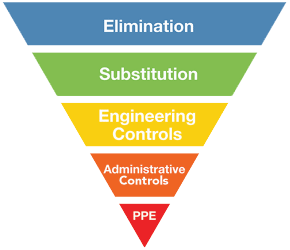Diesel exhaust (DE), sometimes referred to as diesel engine exhaust (DEE,) is produced by diesel internal combustion engines. It is a complex mixture of particulates and gases, composed of carbon dioxide, carbon monoxide, water vapour, ammonia, sulphur oxides, nitrogen and nitrogen oxides, alcohols, aldehydes ketones, hydrocarbons, and aromatic compounds including benzene and poly aromatic hydrocarbons (PAHs). The particulates are collectively referred to as diesel particulate matter (DPM), which consist of elemental carbon (EC), organic carbon compounds adhered to solid matter (including PAHs), metallic particles, sulphates, silicates, and other trace compounds. The majority of DPM is less than 10 micron (PM < 10 µm).
Health Effects
Short-term health effects associated with DE exposure include: eye and nose irritation, respiratory tract irritation, headache, nausea, light-headedness, or worsening of asthma. Long-term exposure to DE includes lung cancer (IARC Group 1 carcinogen), and increases the risks for chronic obstructive pulmonary disease (COPD), idiopathic pulmonary fibrosis (IPF), and bladder cancer.
Industries and Exposures
Individuals are exposed when they breathe in air containing DE. In workplace settings, DE exposure is higher: when in indoor areas, such as mining or warehouses with diesel-powered equipment; or if near a diesel engine, such as when standing next to a rig or a generator even when the worker is outdoors. It can be even higher indoors without sufficient ventilation; the levels of DE may accumulate in spaces like warehouses and garages over time further putting the workers at risk.
Ontario has an occupational exposure limit for total carbon (TC) in the mining sector only: R.R.O. 1990, Regulation 854 (https://www.ontario.ca/laws/regulation/900854) legislates a TC limit of 0.4 mg/m3. The regulation goes on to specify 0.4 mg/m3 TC is equal to 0.31 mg/m3 elemental carbon (EC) using a TC:EC ratio of 1.3. However, this 1.3 ratio is not always supported in current scientific literature for every type of diesel combustion engine. EC is a more precise measurement more broadly accepted.
OHCOW recommends an occupational exposure limit for DE measured as EC, specifically set at 10 µg EC/m3, or 0.010 mg EC/m3, with “exposure to all routes should be carefully controlled to a level as low as possible.”
Hierarchy of Controls for Diesel Exhaust

Elimination is the highest level of hierarchy of controls, but it is not practical to eliminate diesel engines in many industrial settings. Substitution is the next level in the hierarchy of controls. It may be possible to adopt other sources of power for engines in some settings, whether powered by other fossil fuels, or by alternative sources of energy. In settings where diesel engines are the only option, priority could be given to procuring engines that produce the lowest emissions. It may be a small difference in price to buy the lowest emission diesel engine, but it will translate to a reduction in exposure to DE.
Engineering controls for diesel engines can include: ensuring engines are in optimal conditions with a preventative maintenance schedule; ensuring indoor ventilation is as high as possible with adequate air changes of fresh or appropriately filtered air; retrofitting existing devices with new control technologies to reduce emissions; having a ventilated operating room; and/or ensuring diesel engines are not located outdoor near air intakes.
Administrative controls can include: policies to minimize idling; and procedures to minimize work time in proximity to diesel engines. Personal protective equipment is not typically useful in most common situations, but respirators with self-contained breathing apparatuses (SCBA) or supplied airlines (SAR) can be an option.
Resources
Tool
Diesel Exhaust Risk Calculator (OHCOW tool)
Slides
Emissions-based Diesel Engine Maintenance: Reducing Worker Exposure to Diesel Emissions
Diesel Exhaust Calculator Background
Webinars
Diesel Engine Exhaust Profile (CAREX Canada)
Diesel Exhaust Fact Sheets (CCOHS (Canadian Centre for Occupational Health & Safety))
Diesel Engine Exhaust (Occupational Cancer Research Centre (OCRC))
Diesel Exhaust (Collaborative on Health and the Environment (CHE): Toxicant and Disease Database)
Diesel Exhaust Control Measures (U.S. OSHA (Occupational Safety and Health Administration)


